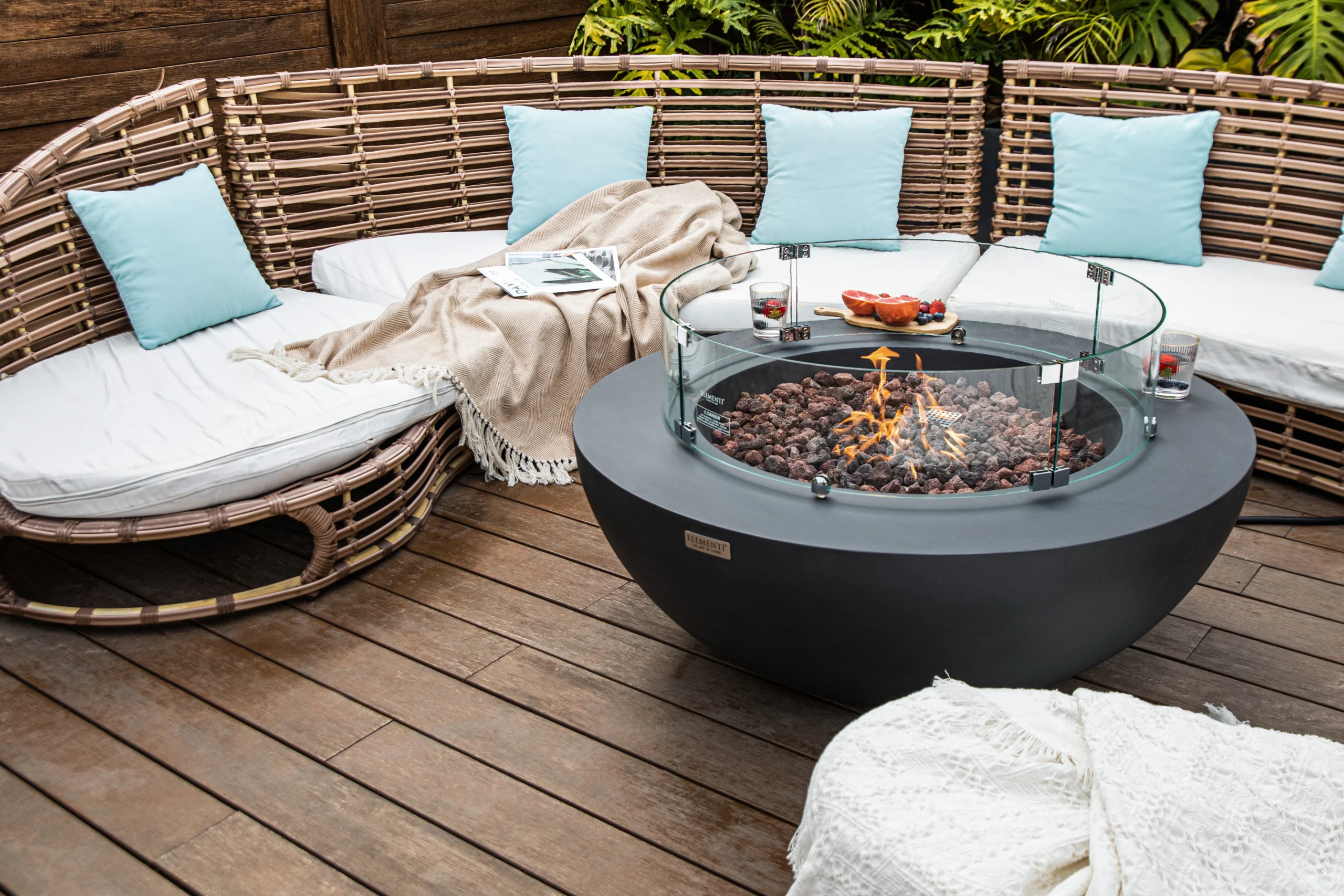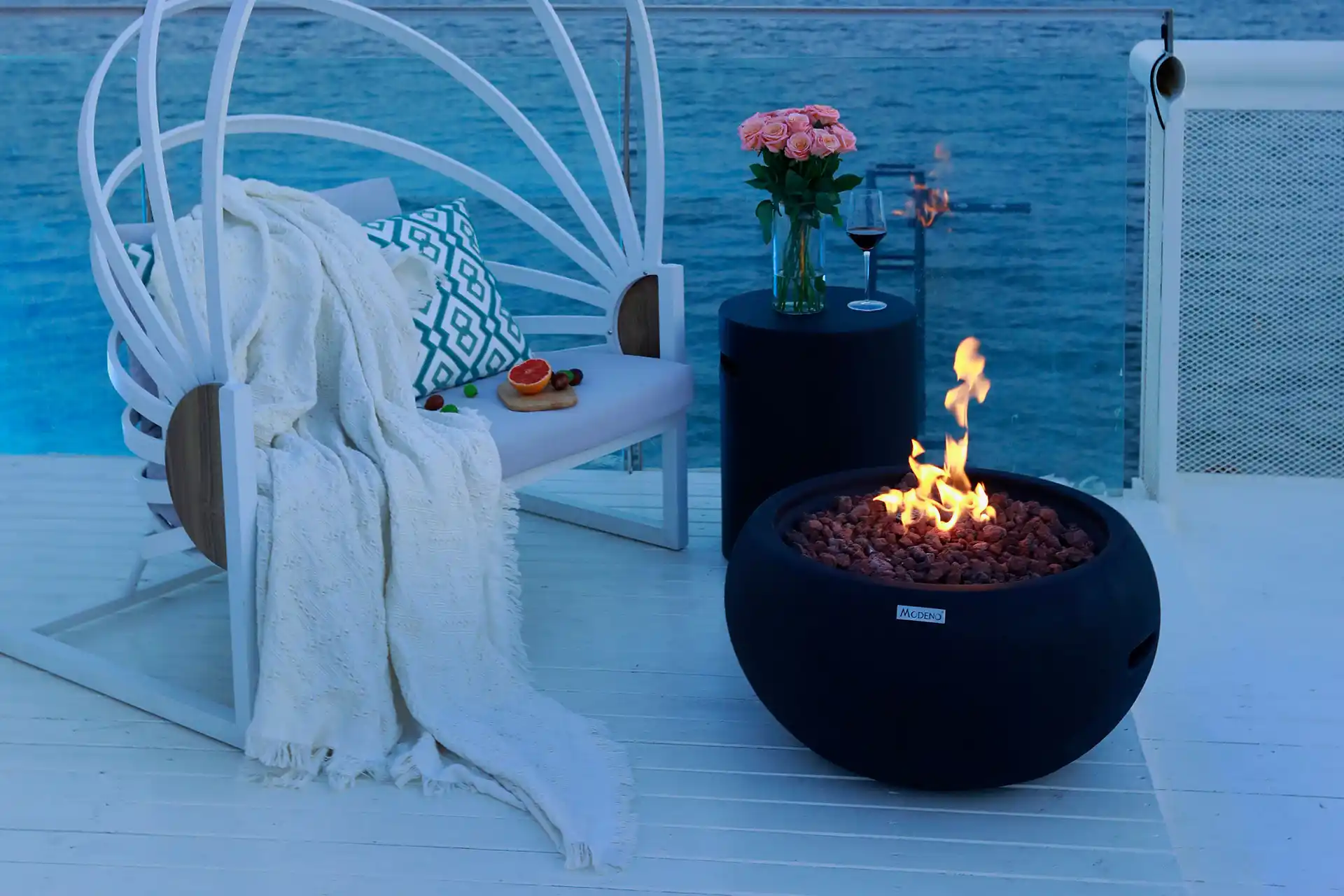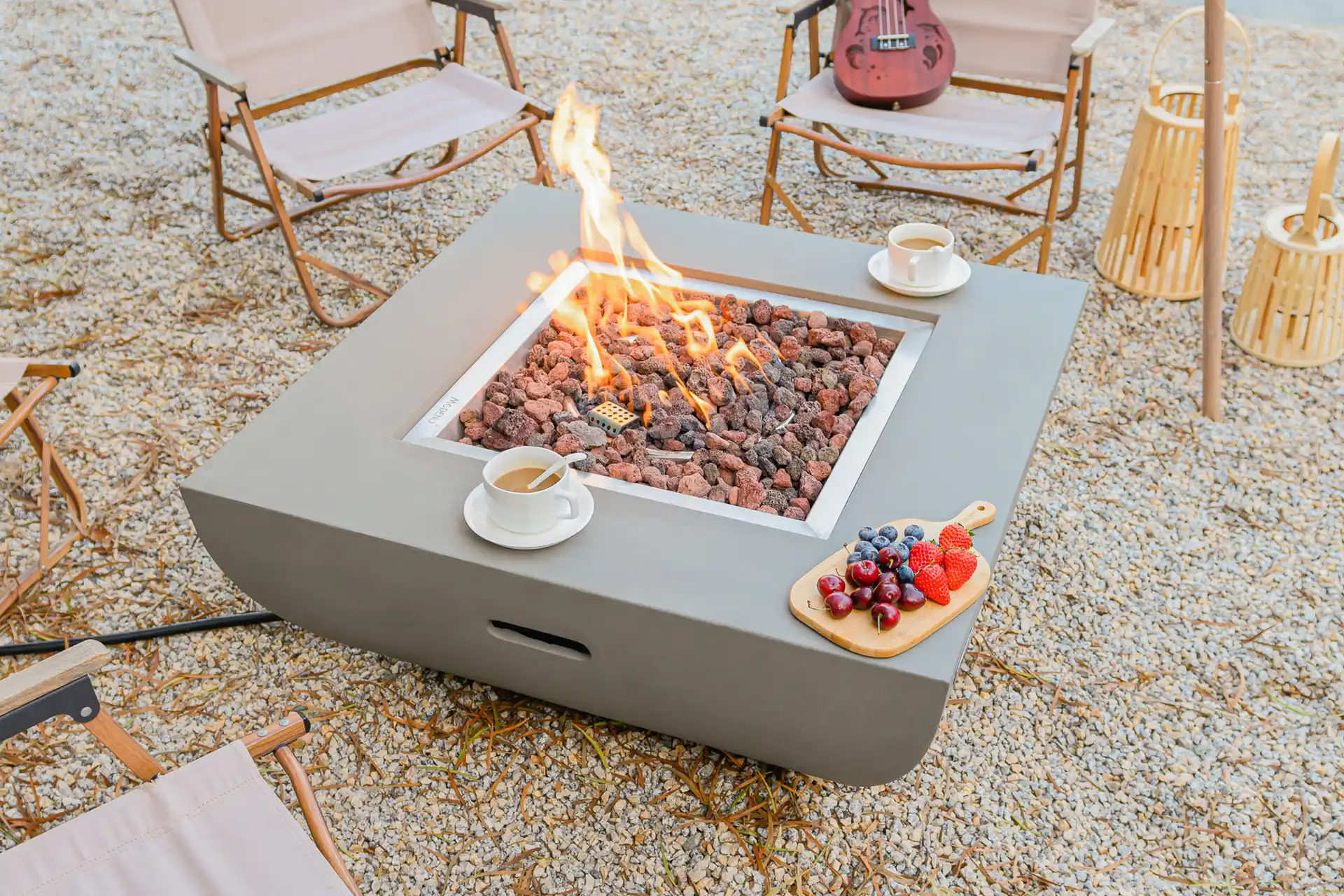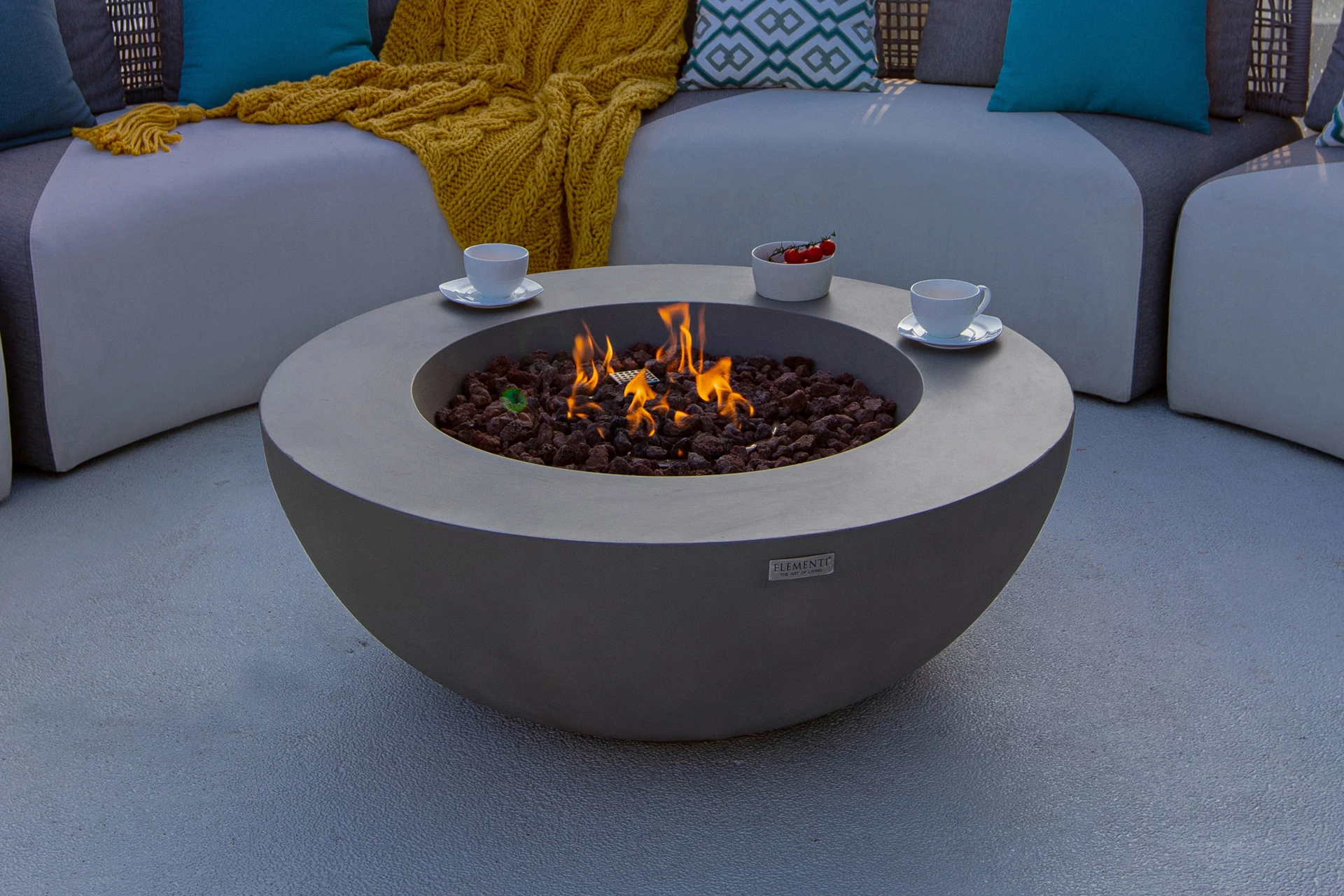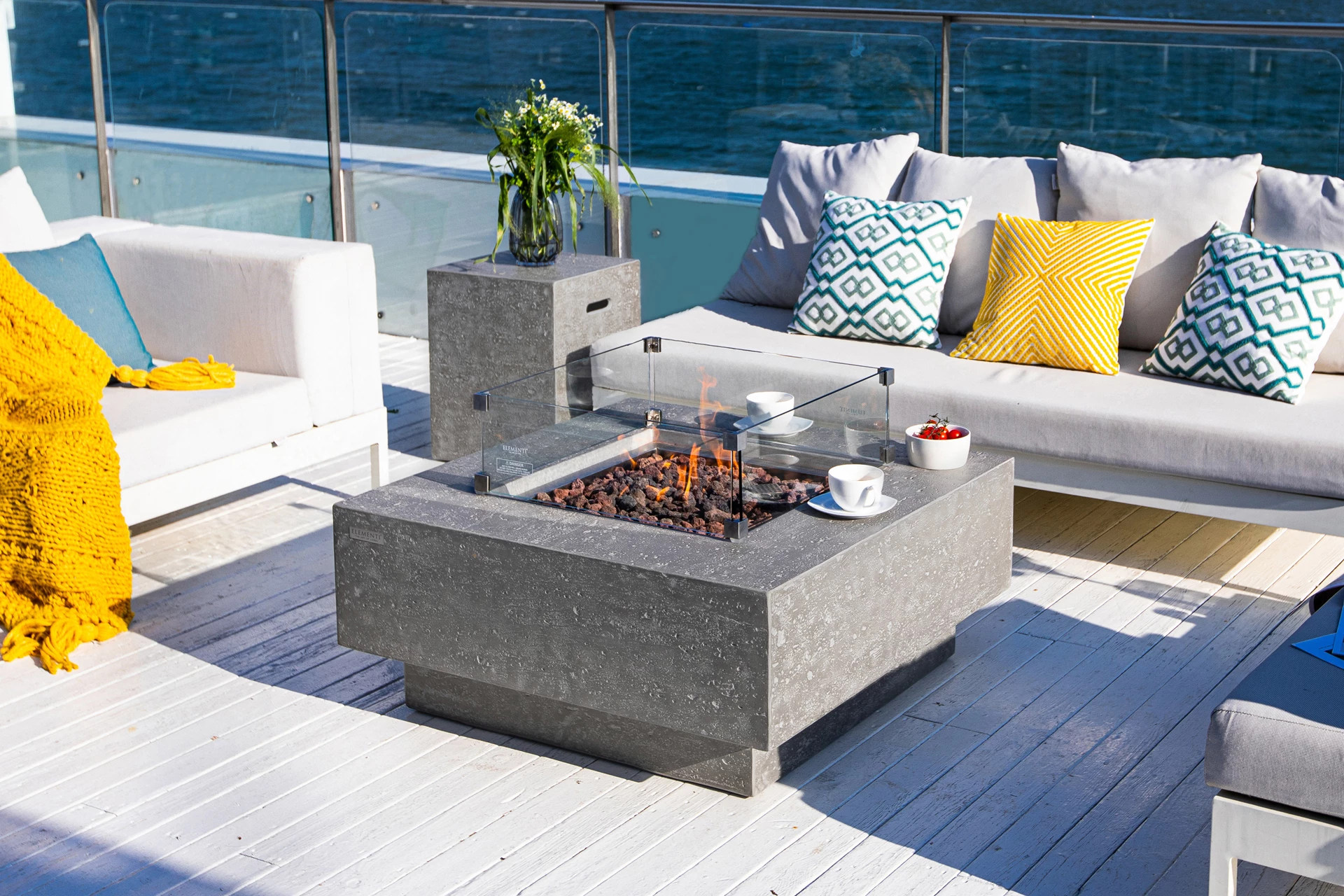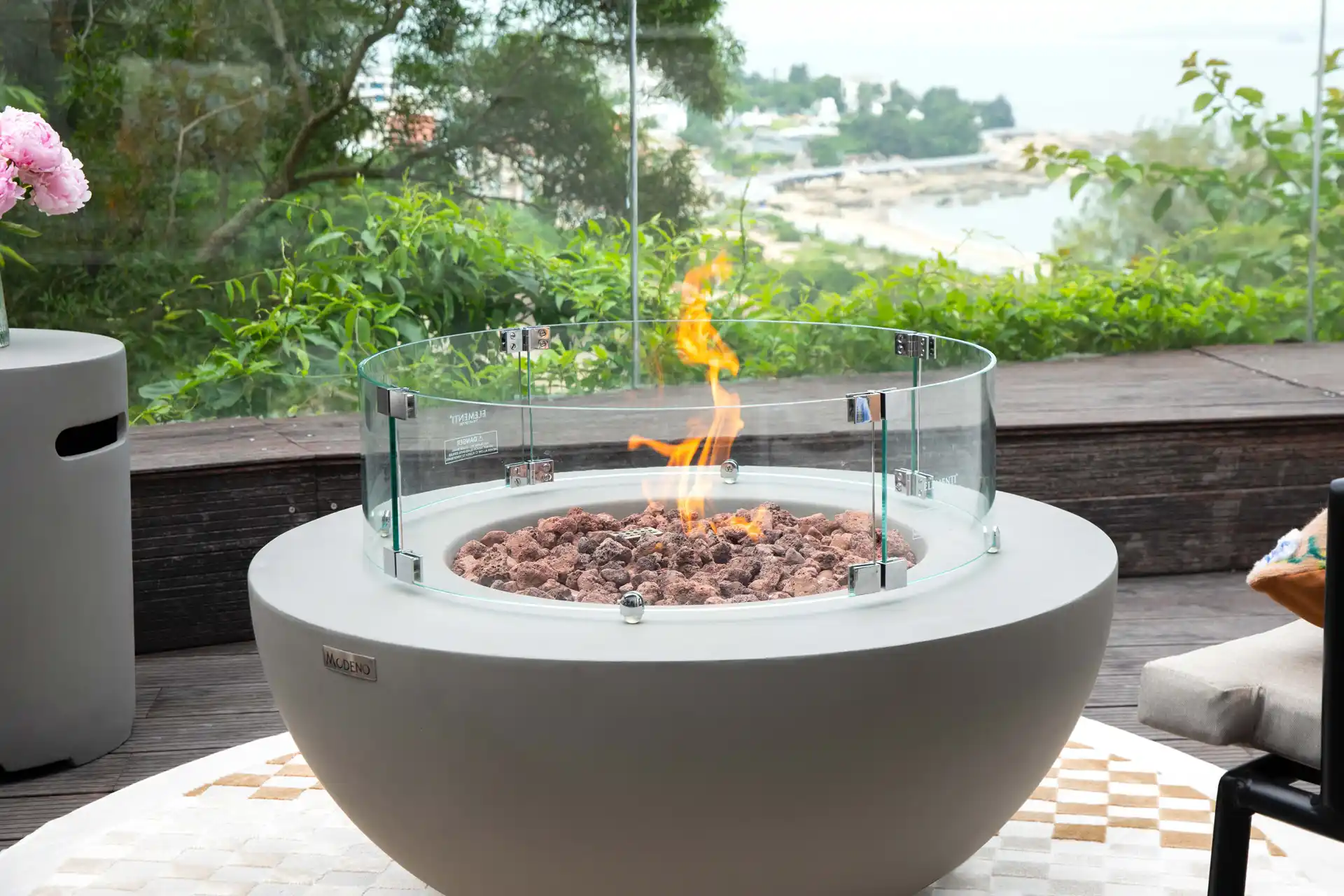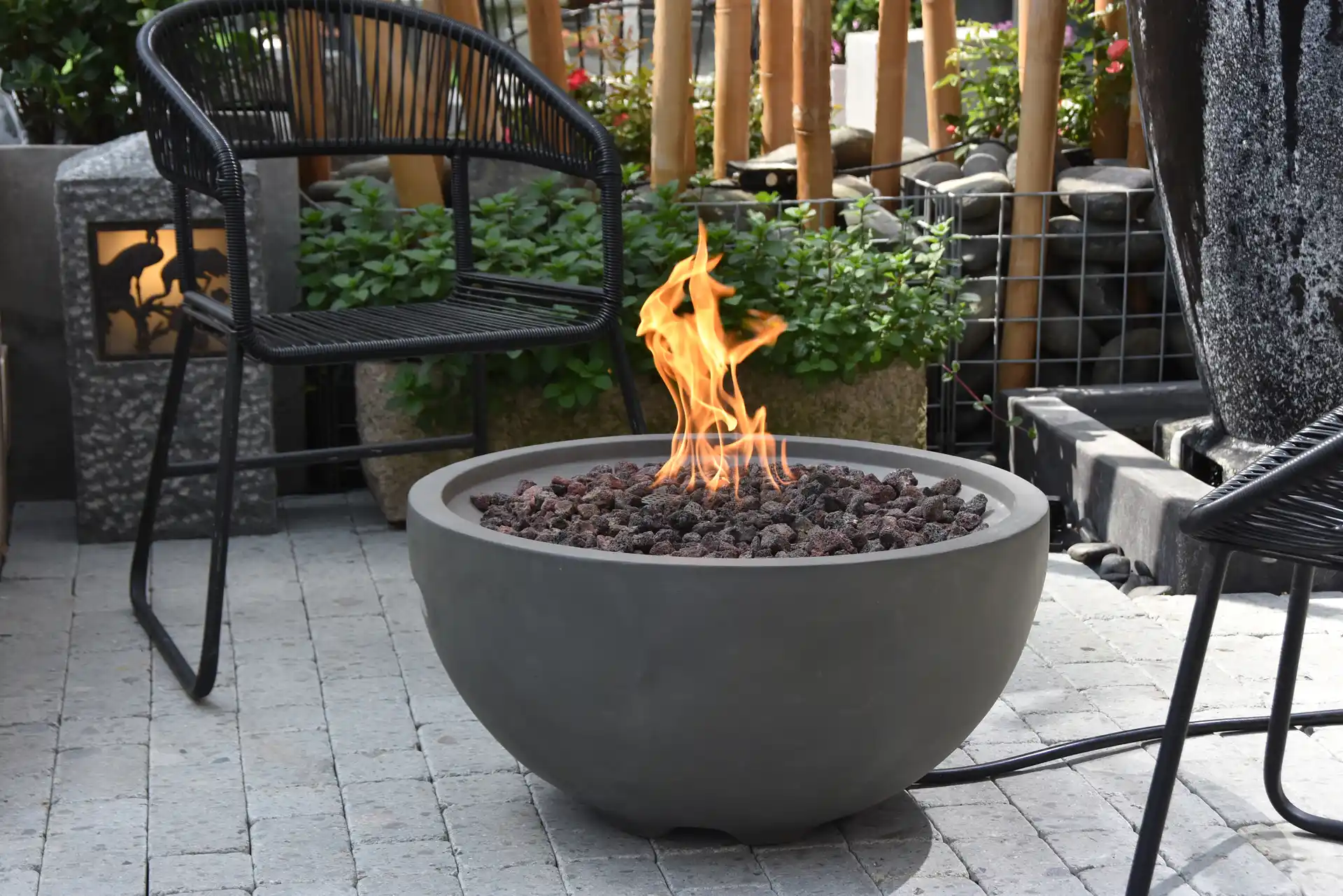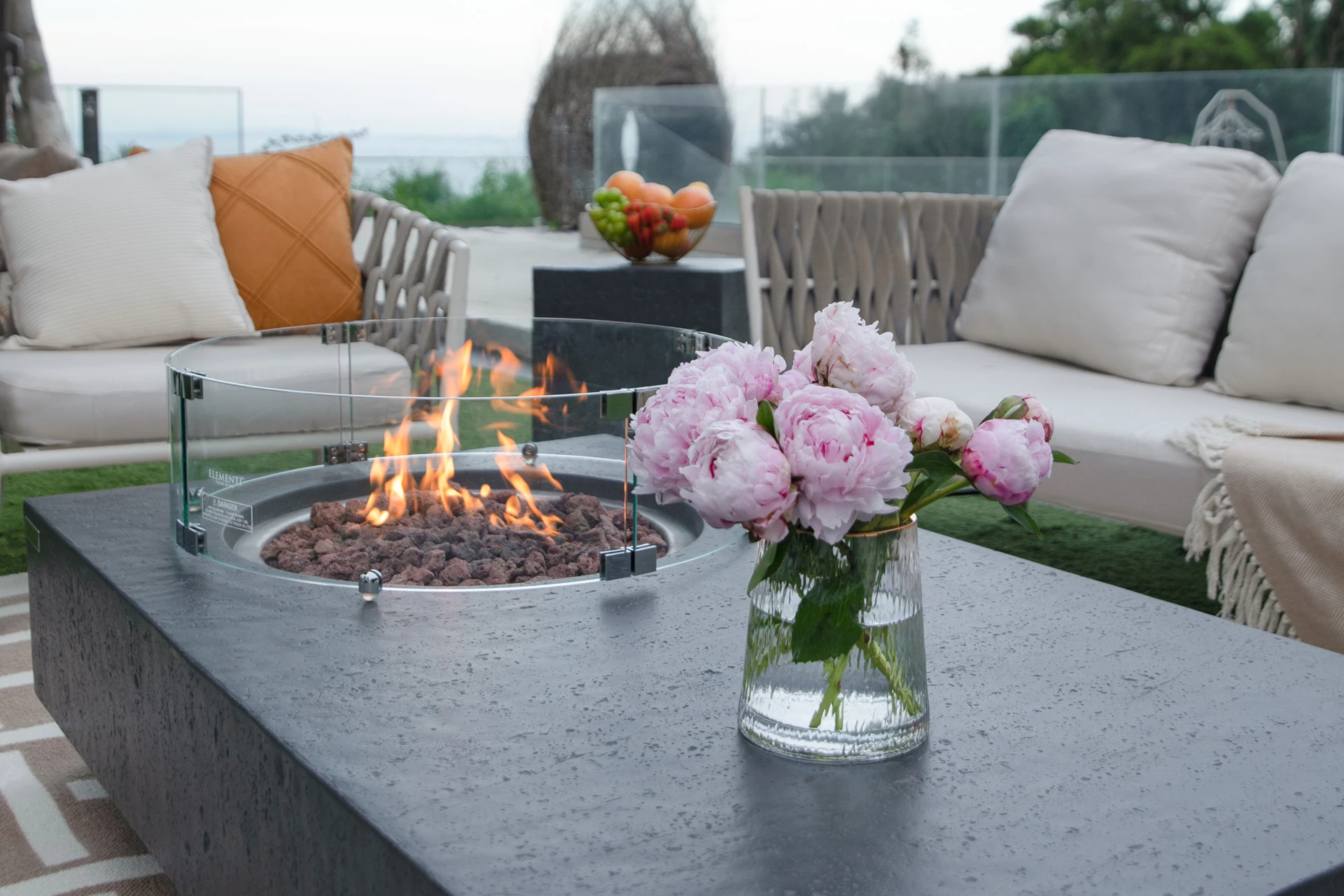1 Important points
- Basic sizes: Small (60-90 cm), Medium (90-110 cm), Large (110-150 cm); leave 180-210 cm clearance all around; use a fireplace size calculator to measure.
- Type and fuel: Wood fires need more space (heat / sparks), gas fires can be closer; portable models (60-75 cm) are suitable for small areas.
- Guide value seating capacity: 2-4 persons = 60-90 cm; 4-6 persons = 90-110 cm; 6 + persons = 120 cm +; 1.7-2.2 m² seating area per person.
- Design & style: Adapt shape / size to patio style (e.g. 105 cm round = rustic, 140 cm rectangular = modern).
- Safety rules: Distance to buildings 3-7.5 m; gas = 1.5-3 m; install only on a non-combustible surface; observe local regulations.
- DIY or professional: Small fireplaces = DIY suitable; large / custom-made = hire a professional; use a gravel base, ventilation openings and fire ring for safety.
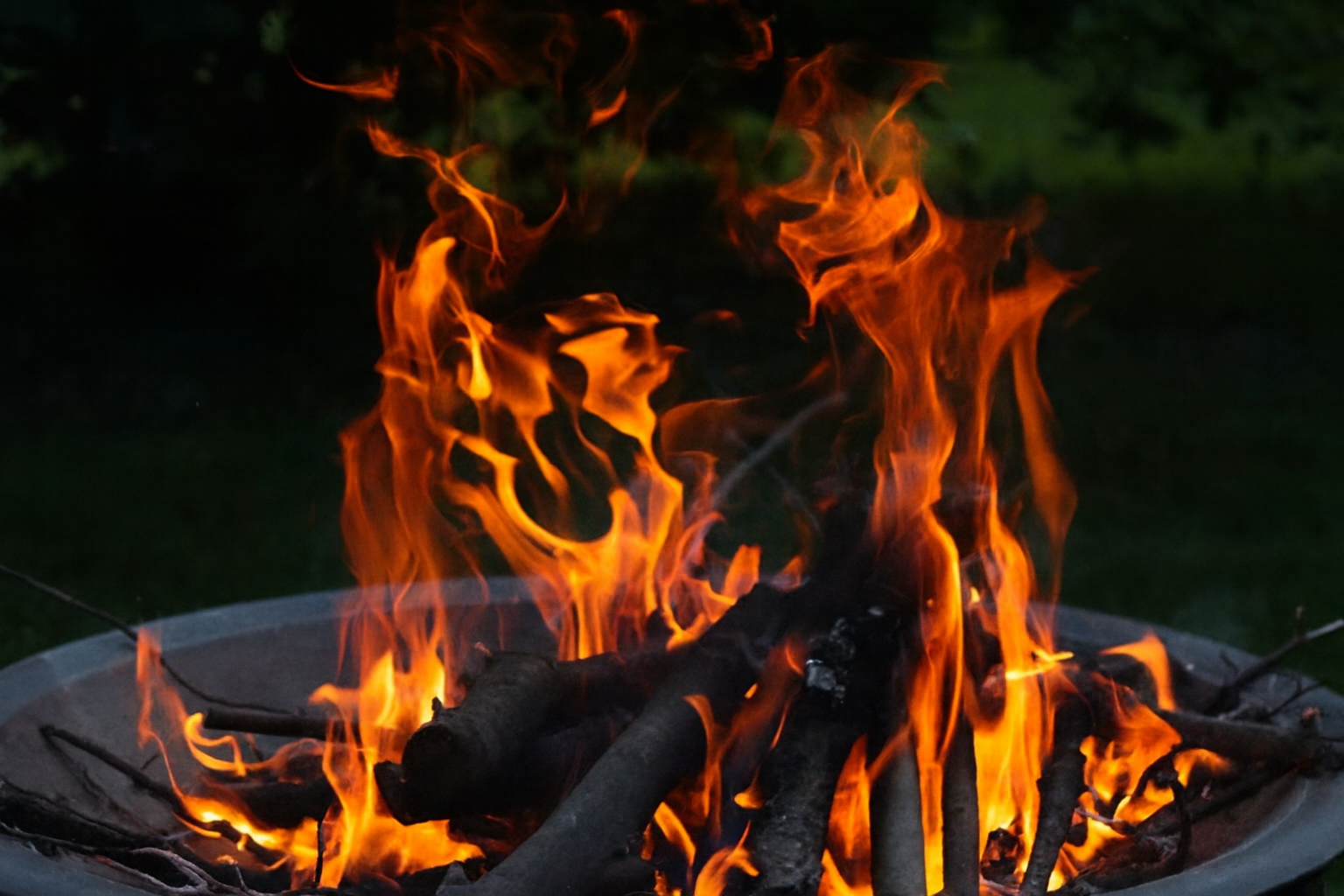
2 Factors in the choice of fireplace size
2.1 Rate available outdoor space
First estimate your available outdoor space. The fire pit should fit in with your layout, not work against it. For safety and comfort, you need at least 180 to 210 cm of free space all around.
For a small patio: choose a fire pit with a diameter of less than 90 cm – functional without being cramped. If you have a lot of space, e.g. a garden area with room to move around, models 120 cm or larger are ideal – more seating and visually more impressive.
Also consider walking routes and eating areas so that the fireplace does not disrupt the flow of movement.
A beautiful garden with wooden benches shows recommended fire pit sizes and seating distances.
2.2 Suitable fireplace type and fuel
The type of fireplace and the fuel determine the appropriate size.
Wood fires require more space – at least 90 cm safety distance for heat and flying sparks.
Gas fireplaces (propane or natural gas) burn cleanly and protected so that the seats can be closer, about 45-60 cm apart.
Portable fireplaces with a diameter of 60-75 cm are suitable for small areas or if you want to move around flexibly.
Think about how you use the area: For convenience and cleanliness, gas is ideal; for an authentic crackling and campfire feel, wood remains unbeatable. Read more in our detailed comparison of gas and wood fires.
2.3 Size according to number of persons

The usual number of guests determines the optimum size:
2-4 persons: 60-90 cm – compact and easy to care for.
4-6 persons: 90-110 cm – good balance between warmth and space.
6 + persons: from 120 cm – more heat, space and longer burning time.
Tip: Cover 1.7-2.2 m² of seating area per person for comfortable seating without crowding.
Take a look at our small and large fire pit series
2.3.1 BTU output by number of persons
In addition to the size, the heat output (BTU) is decisive for comfort. The table below shows guide values according to the number of people, fireplace size and climatic conditions:
| People / Seats | Recommended diameter | Recommended BTU | German |
|---|---|---|---|
| 2-4 | 60-90 cm | 25 000-45 000 | Small terrace; glass protection recommended. |
| 4-6 | 90-110 cm | 45 000-65 000 | Balanced for families and medium-sized meetings. |
| 6-8 | 110-140 cm | 65 000-85 000 | Large seat ring; ensure ventilation. |
| 8 + | 140-150 cm + | 85 000-120 000 + | For events; fixed gas line recommended. |
- With glass protection, thermal efficiency increases, BTU can be reduced by ≈ 10 %.
- Square or rectangular tables concentrate the heat, BTU – 5-10 %.
Discover the right gas fireplaces for your number of people
Want to calculate more precisely? Take a look at the BTU calculator below:
2.3.2 BTU calculator
The BTU output determines how much your fireplace heats up and how comfortable your guests feel. The larger the fireplace or seating area, the higher the BTU rating should be. For a detailed explanation and exact calculation, see our complete BTU guide and the BTU calculator on our website.
2.4 Safety, obstacles and local regulations
Security is not a “nice-to-have”, but a must. Please note before installation:
Distance of the fireplace: Place it 300-760 cm away from buildings, fences or overhangs.
Substrate: Only install on non-combustible surfaces, e.g. paving, gravel or Beton. Avoid grass or wooden decks, unless raised and with suitable shielding.
Ventilation: Gas fireplaces need an air supply; plan opposite openings (at least approx. 116 cm²).
Local rules: Check with city/district or homeowners association (HOA). Recessed fireplaces or gas supply lines may require a permit.
If you follow these guidelines, your setup will be compliant and stress-free from day one.
3 Understanding fireplace sizes
For centuries, fireplaces have been places to gather, warm and cook. In their simplest form, they keep the fire safely in place and provide control.
Today, the range extends from simple floor bowls to architectural accents that are perfect for outdoor design.
The size is decisive for type and function. Portable fireplaces are usually smaller – ideal if you want to remain flexible or only want to use a small amount of space.
Large, stationary fireplaces (e.g. similar to the models from Prism Hardscapes) serve as focal elements in spacious areas. Recessed fireplaces, outdoor fireplaces, fire tables or ring fireplaces differ in size, aesthetics and function.
3.1 Fireplace size calculator: estimate ideal dimensions
The size calculator helps you to determine the ideal area for your fireplace. Enter the available area dimensions, desired seating and recommended seating area per person – and you will receive the remaining area for the fireplace.
This allows you to plan sufficient comfort around the fireplace and stay safe at the same time.
3.2 Recommended sizes according to use
The right size depends on how many people you normally invite, how big your patio is and how you want to use the fire pit. The table provides a quick guide and further information.
| Size range | Diameter range | Required total width | Suitable for | Recommended products |
|---|---|---|---|---|
| Small | 60-90 cm | ≈ 183-244 cm | 2-4 persons | MODENO York gas fireplace |
| Medium | 90-110 cm | ≈ 244-366 cm | 4-6 persons | Elementi Westport gas fire pit |
| Tall | 110-150 cm | ≈ 305-488 cm | 6+ persons | Elementi Lunar Bowl gas fire bowl |
3.3 Small fireplaces (2-4 persons)
Diameter: 60-90 cm
Required overall width: min. approx. 183-244 cm
Suitable for: Couples, small families
Popular types: Fire bowls, small propane models, portable fireplaces
If you have little space but still want to enjoy an open fire, small fire pits are ideal. They are easy to maintain, consume little fuel and fit well on balconies, terraced house terraces or in the camper. They create a cozy atmosphere for 2-4 people without dominating the yard.
3.4 Medium-sized fireplaces (4-6 people)
Diameter: 90-110 cm
Total width required: approx. 244-366 cm
Suitable for: Families, relaxed rounds
Popular types: round/square fire tables, patio kits, hybrid wood/gas
This size strikes the best balance between warmth and space. For 4-6 people, it provides a comfortable seating circle without overcrowding the patio – ideal for suburban areas or if you’re planning accessories such as grills or glass protectors. → Discover accessories
3.5 Large fireplaces (6+ people)
Diameter: 110-150 cm
Total width required: approx. 305-488 cm
Suitable for: Hosts, large families, large yards
Popular types: custom-made built-in fireplaces, XL steel trays, integrated stone solutions
If you like to host, a large fireplace creates a strong focus. More warmth, longer burning times and a striking eye-catcher – perfect for surrounding benches, seating walls or spacious terraces. Whether you’re roasting marshmallows or hosting a garden party: this is the stage.
Related: How to light a fire in the fireplace
3.6 Size aspects according to fireplace type
3.6.1 Recessed fireplace: depth and diameter
Recessed fire pits are durable and add rustic charm to any outdoor area. Depth and diameter are key factors:
Depth: Ideally approx. 15-30 cm. This gives the fire sufficient air and keeps it stable. Too shallow = less safety (embers can escape), too deep = less oxygen, more smoke.
Diameter: Depending on requirements: For small rounds approx. 91 cm, for larger groups 122 cm or more. The larger, the more heat – but also higher fuel consumption.
3.6.2 Tabletop fireplaces: Mobility & usability
Tabletop fireplaces are the perfect choice for anyone who wants to remain flexible and regularly change their ambience – whether on the balcony, dining table or when camping.
Mobility: Small models are particularly light and handy – ideal for spontaneous use indoors or outdoors.
Usability: Larger tabletop fireplaces offer longer burning times and more intense flames, but remain compact enough for mobile use. The heat effect increases with increasing size, while portability decreases slightly.
→ Discover table fireplaces now
3.6.3 Natural gas, wood & propane: flame control & fuel storage
The size influences the flame pattern and fuel placement:
Flame control: Larger = more space for flame development, impressive look – but higher consumption. Small fires remain lively, but are easier to tame.
Fuel storage: Wood: larger boilers = more wood, longer fire. Gas: larger tables = space for integrated propane cylinders, but higher consumption. Pay attention to elegantly concealed cylinder holders for efficiency and appearance.
Always consider your specific use case when choosing the size – there is no universal solution.
4 Terrace & seating area sizes
4.1 Square fireplaces – optimal seating area
A well-planned seating area is crucial for comfort and safety. With square gas fireplaces, a distance of around 100-150 cm between the edge of the fireplace and the seating area is usually sufficient – this ensures pleasant warmth without heat build-up.
If you are also planning a walking area, add around 90 cm for comfortable freedom of movement. Example: A fire pit with an edge length of 120 cm requires a total space of around 3.6 × 3.6 m (120 cm fire pit + 150 cm seat + 90 cm walkway on each side).
4.2 Round fireplaces – optimum seating area
Round fireplaces create an intimate, sociable atmosphere. The ideal distance between the seat and the flame is around 120-160 cm, depending on the size and heat output of the fireplace.
With a round fire pit with a diameter of 120 cm, this results in a total seating radius of approx. 3.6-4.4 m including freedom of movement – perfect for cozy evenings with friends.
4.3 Terrace layout: design, flow & safety
How to plan around the fireplace:
Position the fireplace centrally – this creates focus and organizes the flow of people. Good layouts ensure comfort and safety, especially when planning the seating radius.
Proven layering: Fire pit → 90-120 cm open space → seat → approx. 120 cm walkway. This pattern follows tried-and-tested patio principles and gives everyone space to move around and entertain.
Integrated seating solutions (e.g. stone benches/seating walls 90-120 cm apart) create a durable and uncluttered look. For flexibility, opt for lounge chairs that you can rearrange.
Round off your setup with decorations, low-voltage lighting, stone borders and planters – for zoning, safety and more appeal.
4.4 Minimum terrace sizes according to seating capacity
Small fireplace (2-4 seats): min. approx. 305 × 305 cm
Medium fire pit (4-6 seats): recommended approx. 366 × 366 cm
Large fire pit (6-8+ seats): round Ø 549-610 cm or approx. 549 × 549 cm
Regardless of the number of seats: plan a walking area of approx. 90-120 cm around the seats so that guests can pass comfortably and safely.
4.5 Path spacing & placement tips
Keep paths around seating areas at least approx. 122 cm wide so that you can pass comfortably.
Place the fireplace away from doors, HVAC outlets or easily flammable plantings.
For gas fireplaces: Hide and protect pipes – ideally rigid pipes with overflow valve according to NFPA.
Friends make music and enjoy the evening around the stone fireplace – the scene shows practical diameters and seating distances for social gatherings.
4.6 Safety guide for placement
4.6.1 Minimum requirements
Wood fires: 300-760 cm away from house, garage, fence, trees and flammable structures.
Gas fireplaces: 150-300 cm distance is usual (check local regulations and manufacturer’s instructions).
NFPA recommends: at least 91 cm safety radius around the fireplace; seat distance approx. 213 cm. These rules are central to safe sizing and placement decisions.
4.6.2 Wind & material safety
Avoid highly windy areas; use windscreens or low walls to reduce smoke/glow.
Install the fireplace on non-combustible, level surfaces (stone, paving, gravel, Beton). No uneven grass, no wooden decks without approved heat protection mats.
Top clearance: For gas fireplaces at least approx. 183 cm from flammable surfaces; wood fireplaces require an open sky.
4.7 Small vs. large: advantages and disadvantages
4.7.1 Small fireplaces – advantages & disadvantages
Advantages:
- Mobility: lightweight and convertible – ideal for frequent layout changes or camping.
- Maintenance: lower fuel consumption, easy cleaning.
- Safety: less fuel = less risk.
Disadvantages:
- Heat output: limited heat range – less suitable for large areas.
- Seating: more for intimate rounds; less capacity.
4.7.2 Large fireplaces – advantages & disadvantages
Advantages:
- Heat: more power, larger zones can be heated.
- Socializing: more seating, comfortable atmosphere for larger groups.
Disadvantages:
- Space requirements: take up more space, rarely portable.
- Maintenance: higher fuel consumption and cleaning effort.
The choice depends on your context:
- Space: Compact areas → small; wide terraces/gardens → large.
- Use: heat/cooking/decorative focus? Large models are suitable for large-scale heat & cooking; small ones for atmosphere.
- Events: Large rounds → large; intimate evenings → small.
4.8 Installation tips: DIY vs. professional
Size influences complexity and feasibility. We compare DIY and professional installation, give step-by-step instructions for DIY for typical sizes and show when professionals are advisable.
DIY vs. professional
Smaller, simple designs are DIY-friendly – easy to do with basic tools and basic knowledge.
With increasing size/complexity, the professional pays off: he/she observes safety standards, dimensions correctly and adapts the design exactly to your space.
4.8.1 DIY – step by step
Step 1: Planning & preparation
Define size and location. Check local regulations and permits. Material & tools: Firebrick or natural stone, gravel, sand, spade, spirit level, protective clothing.
Step 2: Marking & excavation
Mark out outline with stakes/string. Excavate to the desired depth/size – a stable, level surface is essential.
Step 3: Assembly
Place ballast layer (drainage). Join the bricks/blocks tightly along the perimeter, mason in layers up to the target height. Check each layer with a spirit level. Leave an opening for air supply; optionally insert fire ring/insert for additional protection.
Step 4: Finish
Place sand bed on the floor. Check evenness, correct if necessary. Clear the surrounding area of combustibles.
4.8.2 Professional installation
Specialist companies assess the area, recommend sizes, plan & build in accordance with standards and safely – including choice of materials, ventilation, distances and (for gas) pipe & valve technology. The result is an aesthetic, long-lasting solution that enhances your room.
4.9 Frequently asked questions about the size of the fireplace
The fire pit should take up a maximum of one third of your patio area. Measure your outdoor area and subtract seating and safety distances. Example: For a 460 × 460 cm patio, the fire pit should be no wider than approx. 125 cm. Leave at least 180-220 cm of free space all around – for seating and movement.
The optimum diameter is 90-110 cm – universal and family-friendly. This size offers space for 4-6 people, with an ideal ratio of heat output to space. Choose the shape (round/square) according to the patio layout, and don’t forget the seating distance.
Yes – a 75 cm fire pit is enough for 2-4 people. It is compact, perfect for small terraces or balconies and generates enough heat for intimate evenings. Make sure there is at least 210 cm of free space around it. For larger groups, 90-120 cm is more suitable.
A distance of at least 300-760 cm from the building is recommended:
Wood fire: 300-760 cm distance from house structures.
Gas fireplace: 150-300 cm are permissible (check local regulations).
Keep your distance from canopies, trees or ventilation shafts. Check local fire protection regulations or HOA rules before installation.
Typical diameter: 90-110 cm (wood) or approx. 55 cm (gas). Square models usually have internal dimensions of 85-90 cm (wood) or approx. 50 cm (propane). Outer walls should protrude 12-20 cm.
5 Conclusion
The right fire pit size doesn’t just determine the appearance – it guarantees safety, comfort and enjoyment. From small patios to large gardens, this guide helps with measurements, seat planning, safety distances and model selection.
Unsure of the dimensions? Do you need further advice? Write to us at info@elementieu.com – our experts will be happy to help you with questions about size, installation or fuel selection.
Ready to find your perfect fire pit? Discover our fire pits and make your outdoor area the focal point of summer evenings.









